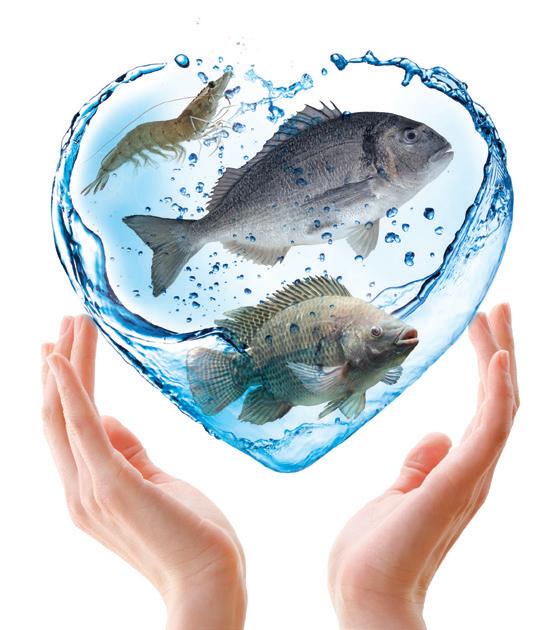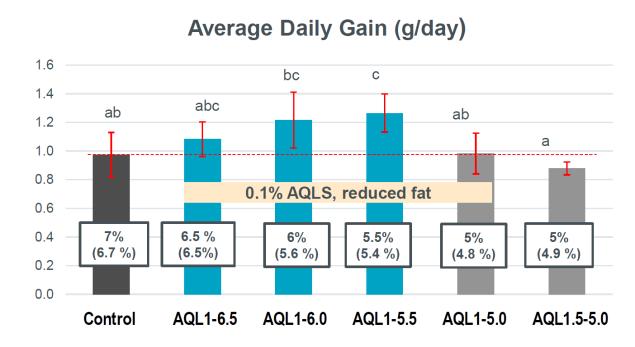
5 minute read
HEALTH IS AT THE HEART OF OUR CONCERNS
Unfortunately, in the past 3 to 4 years, vegetable oil prices have drastically increased in price. Presently prices are on average 1.5 times higher than in Q1-2019 (i.e., at the start of the Covid 19 pandemic) have reached as high as 2.5 to 3 times increase during Q2-2022 mainly due to the Ukraine crisis 1). In parallel, prices of fish oil, traditionally the most expensive of oils, but essential to aquafeeds, not increase so drastically up to mid-2022. Thereafter, however, the price growth of fish oil started outpacing the price of other oils and has reached USD4.3/kg in Q1-2023, i.e., 2.5 times higher than Q1-2019.
so as to minimise erosion of margins and feed performance. Both farmers and feed mills suffer from these high feed prices, and any solution to reduce formulation costs is direly needed.
Figure 1 International prices of aquafeed leading oils from January to March 2023.
This places aquaculture nutritionists in Asia in a quandary since other raw materials have also increase in price, often faster than prices of locally consumed farmed fish. As a result, feed mills had no but to increase feed prices so as to minimise erosion of margins and feed performance. Both farmers and feed mills suffer from these high feed prices, and any solution to reduce formulation costs needed.
Reducing fish oil in catfish feeds

BOOST YOUR BUSINESS BY
Lysophospholipids (LPL) are obtained by controlled enzymatic hydrolysis of lecithin phospholipids renders the molecule more hydrophilic as a consequence of the removal of one fatty acid (Figure This higher affinity to water makes LPL good emulsifiers of oil in water and provides the m with capacity to boost digestion and absorption of lipids. LPL supplementation leads to better utili sation efficiency of the essential lipids and energy provided by dietary fats. Being an industrial producer Adisseo developed the LPL-based Aqualyso® STD with a LPL profile and specification that are highly
RESTRICT inappropriate use of antibiotics and chemicals
REDUCE losses from subclinical disease and outbreaks
INCREASE economical and ecological sustainability
BOOST feed perfomance and farm productivity
Reducing fish oil in catfish feeds
Lysophospholipids (LPL) are obtained by controlled enzymatic hydrolysis of lecithin phospholipids that renders the molecule more hydrophilic as a consequence of the removal of one fatty acid (Figure 2). This higher affinity to water makes LPL good emulsifiers of oil in water and provides them with the capacity to boost digestion and absorption of lipids. LPL supplementation leads to better utilisation efficiency of the essential lipids and energy provided by dietary fats. Being an industrial producer of LPL, Adisseo developed the LPL-based Aqualyso® STD with a LPL profile and specification that are highly adapted to the needs of aquaculture species. Furthermore, the company is a leader in LPL research with over 15 years of shrimp and fish experience addressing specific challenges and application strategies.

Results are summarised in Figures 3 and 4. Addition of 0.1% Aqualyso®STD significantly (p<0.05) improved the growth performance of fish fed feeds with 1% and 1.5% lower oil content. Simultaneously, the FCR of these diets was numerically slightly lower than that of the control feed. Even when fat was reduced by 2%, the additive helped to maintain growth performance at the same level as that of the control feed.


adapted to the needs of aquaculture species. Furthermore, the company over 15 years of shrimp and fish experience addressing specific challenges and applicati
Reducing fish oil in aquafeeds
Reducing fish oil in aquafeeds
A recent trial was conducted at IPB research facility in Bogor, Indonesia, and aimed to evaluate the capacity to reduce oil inclusion in catfish feed while maintaining growth and feed efficiency. Juvenile Pangasius fish (Pangasianodon hypophthalmus) of around 12g/fish were stocked in 30 hapas (2mx1mx1.5m), each with 20 fish, which were fed twice per day for 62 days.
A total of six experimental feeds were tested. A fishmealfree base diet with 31% crude protein (CP) and 7% fat (control) was designed to maximise growth for the experimental fish. Five iso-protein test feeds were formulated at 31% CP under a progressive 0.5% oil reduction down to 5% fat and supplemented with Aqualyso®STD at 0.1% or 0.15%. Overall oil reduction was based on equal reductions of fish oil and palm oil. Formulative changes resulted in potential saving effects ranging from USD13 to USD 51 per tonne of feed. A summary of the experimental feed trial is shown in Table 1.
30 the research facility in
Indonesia Results Aqualyso®STD significantly (p<0.05) improve lower oil content Simultaneously FCR of these diets was feed Even when reduced by 2%, the additive helped to maintain growth performance at the same level as that control feed.
A recent trial was conducted at IPB research facility in Bogor, Indonesia capacity to reduce oil inclusion in catfish feed while maintaining growth and feed efficiency Pangasius fish (Pangasianodon hypophthalmus ) of around 12g/fish (2mx1mx1.5m), each with 20 fish, which were fed twice per day for differences.

A total of six experimental feeds were tested A fishmeal-free base diet with 3 7% fat (control) was designed to maximise growth for the experimental were formulated at 31% CP under a progressive 0.5% oil reduction with Aqualyso®STD at 0.1% or 0.15%. Overall oil reduction was based on equal reductions of fish oil and palm oil Formulative changes resulted in potential saving effects ranging from feed. A summary of the experimental feed trial is shown in Table 1.
The diet with 1.5% reduced oil level and supplemented with 0.1% Aqualyso®STD, not only best growth performance but also in the highest hepatosomatic index (HSI), lowest liver fat lowest viscerosomatic index (VSI) (Figure 4). In line with observations in other species such largemouth bass or Atlantic salmon, the additive optimises fat utilisation and reduces the metabolic disorders associated with excessive fat accumulation in the viscera.
(*) Saving calculation excludes the price of the additive and uses March 2023 international prices of Peru crude fish oil and Malaysia palm oil (as per Hammersmith reports and Indexmundi.com). Saving potential varies between countries with prices of oils and additive.
51 (*) Saving calculation excludes the price of the additive and uses March 2023 international prices of Peru crude fish oil and Malaysia palm oil (as per Hammersmith reports and Indexmundi.com). Saving potential varies between countries with prices of oils and additive.
The diet with 1.5% reduced oil level and supplemented with 0.1% Aqualyso®STD, not only resulted in the best growth performance but also in the highest hepatosomatic index (HSI), lowest liver fat content, and lowest viscerosomatic index (VSI) (Figure 4). In line with observations in other species such as tilapia, largemouth bass or Atlantic salmon, the additive optimises fat utilisation and reduces the risk of metabolic disorders associated with excessive fat accumulation in the viscera.

These growth performance effects of LPL have been proven also with other species, including tilapia, marine fish and salmonids. Similar application strategy and results were also observed in shrimp, in which this Aqualyso® STD allowed for oil or lecithin reduction while maintaining the performance quality of the feed.

In conclusion, within the context of fluctuating oil prices, aquafeed formulators can count on this LPL based product to make aquafeeds perform with less fat and energy levels, and therefore achieve significant cost-reductions. The Service Platform on Aqua Nutrition by Adisseo combines formulation experience and species-specific research on application strategies, and provides advice and services related to aquafeed formulation and processing.











